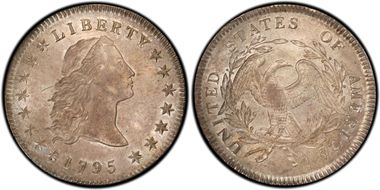1795 $1 Flowing Hair, BB-27 AU50 认证号27986710, PCGS号39977
专家评论
Ron Guth
BB-27 is one of several varieties of 1795 Silver Dollars that comes occasionally with a silver-plug at center. Experts believe the center plug was used to bring an underweight planchet up to the government standard. Upon striking, the plug was smashed and became an integral part of the coin, though sometimes a thin seam can be seen around much or all of the plug's circumference.
Q. David Bowers
The following narrative, with minor editing, is from my "Silver Dollars & Trade Dollars of the United States: A Complete Encyclopedia" (Wolfeboro, NH: Bowers and Merena Galleries, Inc., 1993). Note: the Notable Specimens list should be used with caution - it has been updated in my 2013 edition of "The Encyclopedia of United States Silver Dollars 1794-1804."
Obv: Portrait II (Head of '95)
Rev: Eagle II, Wreath II (3 leaves)
(B-5. H-5.)
OBVERSE 9: Flowing hair in six curls, the 3rd and 4th close together; the 4th has a tiny curved "tail" extending downward, and visible on higher grade pieces. Lowest curl distant from star. A "bar" over 2 mm. long extends diagonally from close to top curl toward point of 5th star. Look for the "bar" near uppermost curl. (By contrast, BB-20 has the bar near 4th star.) Wide date, the 1 and 7 farthest apart. First star about as close to 1 as 7 is to 9. Most early die states show striking weakness at the centers.
As is the case with the obverse die used to coin BB-21, BB-22, and BB-23, the present obverse had the head of Miss Liberty deeply impressed into the die, causing it to be in slightly higher relief than other varieties of the year; because of this, the hair details wore away quickly as the coins circulated.
Obverse die used to strike 1795 BB-27 only.
REVERSE J: Three leaves under each wing. 13 berries, seven on left branch, six on right. Three leaves under each wing of eagle. Two berries under first T in STATES, one on inside and one on outside of wreath. With four leaves below first S of STATES (late state of die, also used to coin BB-25, later state, and BB-26; the state used to strike BB-25, early state, has only three leaves).
Note: All specimens of BB-25 and BB-27 examined by Bolender showed a fine die crack from end of left stem downward, in BB-27 extending to border. However, the crack does not appear on some specimens of BB-27, nor in BB-26 nor BB-26a, indicating BB-26 was struck earlier.
Reverse die used to strike 1795 BB-25 (two states; Die State I with three leaves and Die State III with four leaves under first S in STATES; presumably, one of the leaf recesses in the die was clogged, thus preventing one leaf from striking up), BB-26 (later state with four leaves under first S in STATES), and BB-27 (later state with four leaves under first S in STATES).
DIE STATES:
Die State I: Perfect reverse. None seen by Bolender. However, about one in 20 to 30 1795 BB-27 dollars is of this state. Usually lightly struck at the centers, even on high-grade coins.
Die State II: Crack just beginning from end of the left stem to rim. Cf. Gilhousen (Superior, 1973). Common. Often lightly struck at the centers; even AU and Mint State coins are weak at the centers.
Die State III: The reverse is cracked from the end of the left stem to border; the die crack is not bold. Common. Usually better struck at the centers than Die State II.
Die State IV: Clash marks before the lip and the nose, die roughness in LIBE and at the back of the lower curls. Not seen by the author.
Die State V: Crack from top of 7 to bust. Rare. V. Crack from rim through star 10 to chin. Very scarce. Not seen by the author.
Die State VI: Obverse die buckles from 5:00 to 8:00 at the rim, date weakens. Rare. Not seen by the author.
Die State VII: Obverse die reground; "bar" nearly gone and stars smaller. 1975 ANA Convention Sale (Superior): 793; 1986 ANA: 4708. Very rare. (How does this compare to Die State IV?)
COLLECTING NOTES: 1795 BB-27 is by far the most common variety of 1795. A couple thousand or more exist; I estimate the population to be 2,500 to 3,500 in all grades combined. However, in his 1881 Type-Table, J.W. Haseltine called this variety rare if "strictly Uncirculated." In its day, this die combination may have struck 100,000 or more coins! The die steel must have been especially well tempered.
Due to the depth of the Miss Liberty portrait in the die, the resultant coins were in high relief. Because of this, the hair wore quickly at the center of the obverse, with the result that pieces grading VF or lower usually have little detail still remaining. On some (but not all) higher grade coins, usually Die State III in EF or finer preservation, the hair detail at the center of the obverse and the eagle's breast feathers are well defined. As many as 50 to 100 Mint State coins may exist.
NOTABLE SPECIMENS:
Montgomery Collection. MS-64. British collection. Bowers and Ruddy Galleries. Bowers and Ruddy, Montgomery Collection, 1976: 1998. "Gem Uncirculated with flawless surfaces, well struck with superb hair detail, eagle's feathers on reverse nearly complete in detail. Pedigree: Possibly originally struck as a presentation piece, originally obtained by [us] from an overseas source, [we] subsequently sold it to its present owner who consigned it to [us]."
Matlock Specimen. MS-64. Bowers and Merena, Matlock Collection, 1991: 460. "Fully lustrous, full and unbroken cartwheels seen on both sides, very minor obverse adjustment marks mostly confined to rim, none disfiguring; reverse rim from 10:00 to 1:00 imperfectly struck up, denticles lacking there; all edge lettering fully legible."
























